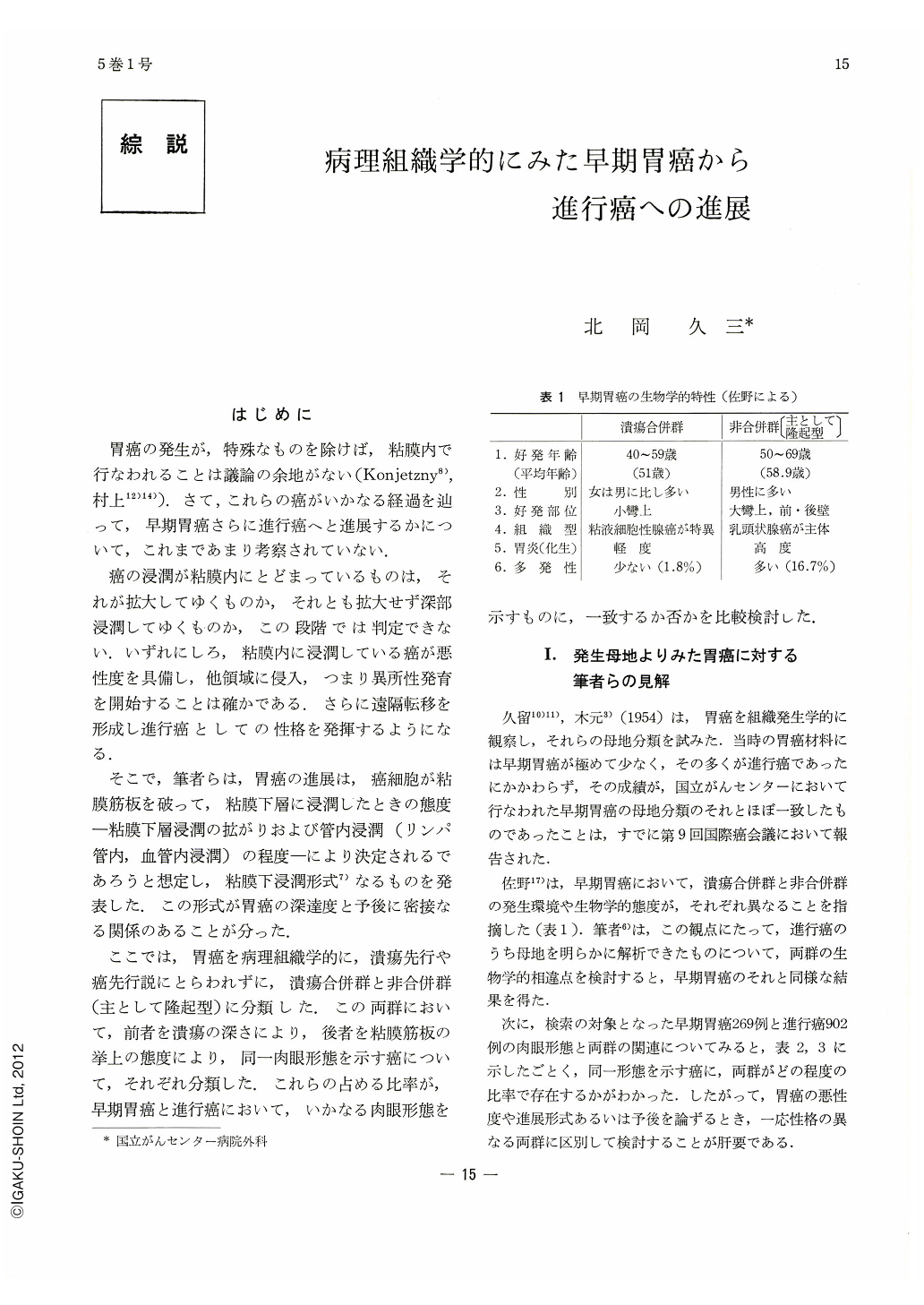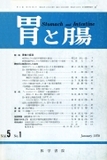Japanese
English
- 有料閲覧
- Abstract 文献概要
- 1ページ目 Look Inside
はじめに
胃癌の発生が,特殊なものを除けば,粘膜内で行なわれることは議論の余地がない(Konjetzny8),村上12)14)).さて,これらの癌がいかなる経過を辿って,早期胃癌さらに進行癌へと進展するかについて,これまであまり考察されていない.
癌の浸潤が粘膜内にとどまっているものは,それが拡大してゆくものか,それとも拡大せず深部浸潤してゆくものか,この段階では判定できない.いずれにしろ,粘膜内に浸潤している癌が悪性度を具備し,他領域に侵入,つまり異所性発育を開始することは確かである.さらに遠隔転移を形成し進行癌としての性格を発揮するようになる.
そこで,筆者らは,胃癌の進展は,癌細胞が粘膜筋板を破って,粘膜下層に浸潤したときの態度一粘膜下層浸潤の拡がりおよび管内浸潤(リンパ管内,血管内浸潤)の程度一により決定されるであろうと想定し,粘膜下浸潤形式7)なるものを発表した.この形式が胃癌の深達度と予後に密接なる関係のあることが分った.
ここでは,胃癌を病理組織学的に,潰瘍先行や癌先行説にとらわれずに,潰瘍合併群と非合併群(主として隆起型)に分類した.この両群において,前者を潰瘍の深さにより,後者を粘膜筋板の挙上の態度により,同一肉眼形態を示す癌について,それぞれ分類した,これらの占める比率が,早期胃癌と進行癌において,いかなる肉眼形態を示すものに,一致するか否かを比較検討した.
Histopathologically two types of gastric carcinoma are classified: with or without coexisting ulcer (mainly protruding type). Accepting the hypothesis of the progress of ‘early' gastric cancer to advanced tumor, the authors have divided polypoid cancer into the protruding type (pedunculated and sessile type) and deep invasive type (elevated plateau type, doughnut type) estimated by the behavior of the muscularis mucosae.
Type 1 in early gastric cancer and Borrmann's type 1 in advanced cancer are mainly of the protruding type. Type Ⅱa and Ⅱa+Ⅱc in the early stage and Borrmann's type 2 and 3 in advanced stage belong to the deep invasive type. Accordingly, type 1 may be transformed into Borrmann's type 1 tumor, while type Ⅱa and Ⅱa+Ⅱc may proceed to Borrmann's type 2 or 3 tumor.
In early gastric cancer in which the coexistence of ulcer within the lesion is confirmed, the depth of ulcer is deeper in type Ⅲ cancer than in Type Ⅱc.
In advanced cancer, the depth of ulcer is deeper among the Borrmann's type 2 tumors than in Borrmann's type 3.
By the same token, type Ⅲ of early gastric cancer may be transformed into Borrmann 2 type tumor in which the coexisting ulcer is usually deeper (Ul-4) and type Ⅱc may proceed to Borrmann's type 3 in which the ulceration is usually shallower (Ul-2, 3).
The predecessor of Borrmann's type 4 tumor may be type Ⅱc of early cancer associated with wide submucosal invasion (sm2 sm3) rather than development of superficial spreading type tumor.

Copyright © 1970, Igaku-Shoin Ltd. All rights reserved.


